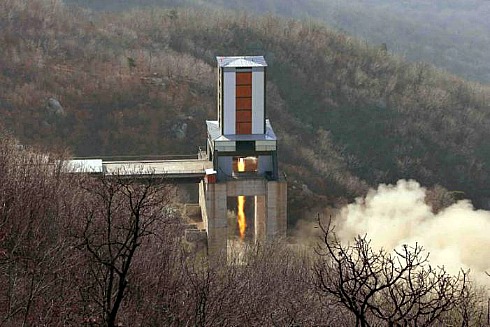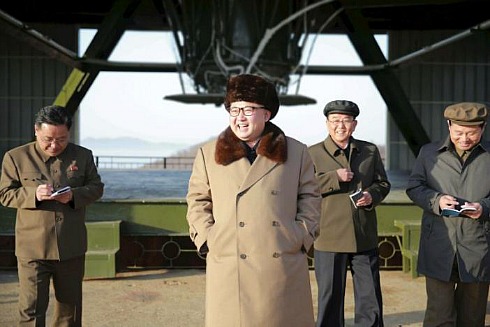Archives
AND MORE...

A Very Disturbing Dot
_____________________

Lies, Damned Lies & BO Lies
_____________________

Sitting Ducks
_____________________

Another 'Fantastic' Deal
_____________________
January 3, 2017
So Now What?
North Korea has been working through 2016 on developing components for an intercontinental ballistic missile (ICBM), making its claim that it was close to a test-launch plausible, international weapons experts said on Monday (see below).
It has been testing rocket engines and heat-shields for an ICBM while developing the technology to guide a missile after re-entry into the atmosphere following a lift-off, said the experts.
And while North Korea's state media regularly threatens the US with a nuclear strike, before 2016 Pyongyang had been "assumed to be a long way from being capable of doing so."
"The bottom line is Pyongyang is much further along in their missile development than most people realize," said Melissa Hanham, a senior research associate at the U.S.-based Middlebury Institute of International Studies at Monterey, California.
Actually, the "bottom line" is we really don't know what's going on in North Korea, nor can we predict with any degree of certainty what stage North Korea has reached with its nuke delivery systems.
Of course, we also don't know what Iran has stashed in North Korea.
The Israelis warned us years ago that a North Korean nuclear test might have also been carried out on behalf of Iran and in the presence of Iranian atomic scientists.
A classified State Department cable from October 2009, which was exposed by WikiLeaks, detailed that Iran is the leading missile customer of North Korea.
AND in 2015, US intelligence officials revealed that during the ongoing Iran nuclear negotiations, North Korea provided several shipments of advanced missile components to the Islamic regime in violation of UN sanctions - and the US hid the violations from the UN.
So the question is: What exactly is the US waiting for before taking any serious action against North Korea and/or Iran? So far, the US has only fed North Korean and Iranian nuclear aspirations.
As Ayn Rand once said: “You can avoid reality, but you cannot avoid the consequences of avoiding reality.”
Reuters | January 2, 2017
North Korea's Claim On ICBM Test Plausible: Experts
By James Pearson | SEOUL

A new engine for an intercontinental ballistic missile (ICBM) is tested at a test site at Sohae Space Center in Cholsan County, North Pyongan province in North Korea in this undated photo released by North Korea's Korean Central News Agency (KCNA) on April 9, 2016. KCNA/via REUTERS/File Photo
North Korea has been working through 2016 on developing components for an intercontinental ballistic missile (ICBM), making the isolated nation's claim that it was close to a test-launch plausible, international weapons experts said on Monday.
North Korea has been testing rocket engines and heat-shields for an ICBM while developing the technology to guide a missile after re-entry into the atmosphere following a lift-off, the experts said.
While Pyongyang is close to a test, it is likely to take some years to perfect the weapon.
Once fully developed, a North Korean ICBM could threaten the continental United States, which is around 9,000 km (5,500 miles) from the North. ICBMs have a minimum range of about 5,500 km (3,400 miles), but some are designed to travel 10,000 km (6,200 miles) or further.
North Korea's state media regularly threatens the United States with a nuclear strike, but before 2016 Pyongyang had been assumed to be a long way from being capable of doing so.
"The bottom line is Pyongyang is much further along in their missile development than most people realize," said Melissa Hanham, a senior research associate at the U.S.-based Middlebury Institute of International Studies at Monterey, California.
She said the North's test in April of a large liquid-fuel engine that could propel an ICBM was a major development.
"The liquid engine test was astounding," Hanham said.
"For years, we knew that North Korea had a Soviet R-27 missile engine design. They re-engineered the design of that engine to double its propulsion".
North Korea has said it is capable of mounting a nuclear warhead on a ballistic missile but it claims to be able to miniaturize a nuclear device have never been independently verified.
The isolated nation has achieved this progress despite U.N. Security Council imposed sanctions for its nuclear tests and long-range rocket launches dating back to 2006. The sanctions ban arms trade and money flows that can fund the country's arms program.
North Korea has enough uranium for six bombs a year and much of what it needs for its nuclear and missile programs relies on Soviet-era design and technology. Labor is virtually free.
It can produce much of its missile parts domestically and invested heavily in its missile development infrastructure last year, funded by small arms sales and by taxing wealthy traders in its unofficial market economy.
PROPAGANDA OFFENSIVE
Throughout the year, North Korean state media showed images of numerous missile component tests, some of which revealed close-up details of engines and heat shields designed to protect a rocket upon re-entry into the earth's atmosphere.
The propaganda offensive may have revealed some military secrets, but it may have also been a bid to silence outside analysts, many of whom had remained skeptical of the North's missile program.

File Photo: North Korea leader Kim Jong Un smiles as he visits Sohae Space Center in Cholsan County, North Pyongan province for the testing of a new engine for an intercontinental ballistic missile (ICBM) in this undated photo released by North Korea's Korean Central News Agency (KCNA) on April 9, 2016. KCNA/via REUTERS/File Photo
"They're answering the public criticisms of U.S. experts," said Joshua Pollack, editor of the U.S.-based Non proliferation Review. "A lot of people had questioned whether they had a working ICBM-class heat shield".
"So they showed us".
Despite the research, Pyongyang has experienced considerable difficulties getting its intermediate-range Musudan missile, designed to fly about 3,000 km (1,860 miles), off the ground. It succeeded just once in eight attempted launches last year.
North Korea has fired long-range rockets in the past, but has characterized those launches as peaceful and designed to put an object into space.
Still, the South Korean defense ministry believes the three-stage Kwangmyongsong rocket used by Pyongyang to put a satellite in space last February already has a potential range of 12,000 km (7,457 miles), if it were re-engineered.
Doing so would require mastering safer "cold-launch" technology, and perfecting the ability of a rocket to re-enter the earth's atmosphere without breaking up.
"North Korea is working hard to develop cold-launch technology and atmospheric re-entry but South Korea and the U.S. will have to assess further exactly which level of development they have reached," South Korean defense ministry official Roh Jae-cheon told a briefing on Monday.
North Korea began stepping up its missile development in March 2016, Roh said, but added that there were no "unusual signs" related to test preparations, according to the South Korean military.
That same month, Kim Jong Un was photographed looking at a small, ball-like object that North Korean state news agency KCNA said was a miniaturized nuclear warhead - the device North Korea would need to fulfill its ICBM threat.
"2016 marked the year North Korea truly ramped up their WMD (Weapons of Mass Destruction) program," Hanham at the Middlebury Institute of International Studies at Monterey said.
"I think we're going to see a (ICBM) flight test in 2017".
Original article here.
Log In »
Notable Quotables
"Mr. Netanyahu is one of the most media-savvy politicians on the planet. On Friday he appeared live via video link on 'Real Time with Bill Maher,' taking the host’s alternately sardonic and serious line of questioning with gazelle-like alacrity."
~ Anthony Grant, jourrnalist who has written for many major newspapers and worked in television at Paris and Tel Aviv, interviewing former PM Benjamin Netanyahu on Monday, at the outset of Mr. Netanyahu's new book (more here).


